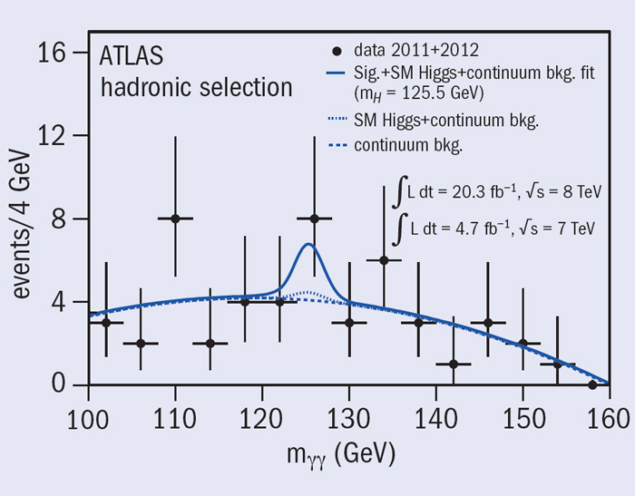Since the observation of a Higgs boson at a mass around 125.5 GeV by ATLAS and CMS in July 2012, both collaborations are making every effort to pin it down and decide if it is indeed the Higgs boson of the Standard Model, or the first member of a somewhat larger family, as predicted by several models that go beyond the Standard Model. Working in this direction, ATLAS used the six million tt pairs produced in Run I of the LHC to look for the possible decay of a top quark or antiquark into a light quark (up or charm) and a Higgs boson, t → qH.

In the Standard Model such decays, which proceed via flavour-changing neutral currents, are highly suppressed, but in more complex models they might be present, albeit with a small branching ratio compared with the dominant t → bW decay. Doing the search using the dominant decay mode of the Higgs boson (H → bb) would lead to final states that are very hard to distinguish from the majority of tt decays. Therefore ATLAS made the choice to use the H → γγ decay mode – which has a clean signature of two photons with high transverse-momentm (pT) clustering as a narrow peak in invariant mass around 125.5 GeV – the power of this decay mode being demonstrated by the Higgs-boson discovery. Unfortunately the use of this decay mode is hampered by a small branching fraction, only 0.23%. Putting numbers together, and taking into account the acceptance of the detector and of the selection, a branching ratio B of 1% for t → qH would lead to about 11 observed events in a topology with two high pT photons and four jets, of which one would be identified as a b-jet. In addition, about three events with two high-pT photons, two jets, a lepton and missing transverse momentum (from the leptonic decay of the W) would also be expected.
After making kinematical cuts to ensure the compatibility of the selected events with the tt final state, ATLAS obtained the diphoton mass-spectrum shown in the figure. This rules out B = 1% immediately because it is clear that there is not an 11-event signal at 125.5 GeV. A detailed statistical analysis gives an expected limit on B of 0.53%. The small, non-significant excess in the 124–128 GeV bin worsens the observed limit to 0.79%, at the 95% confidence level.
This is the first experimental result on this channel and its precision is limited, mainly by the available statistics. When data become available at 13/14 TeV – leading to an increase of the tt- production cross-section of almost a factor of four – and with a larger integrated luminosity, either a much tighter limit will be obtained or, perhaps, a significant signal will show up, giving evidence for physics beyond the Standard Model in the Higgs sector.
Further reading
ATLAS Collaboration 2014 arXiv:1403.6293 [hep-ex].








